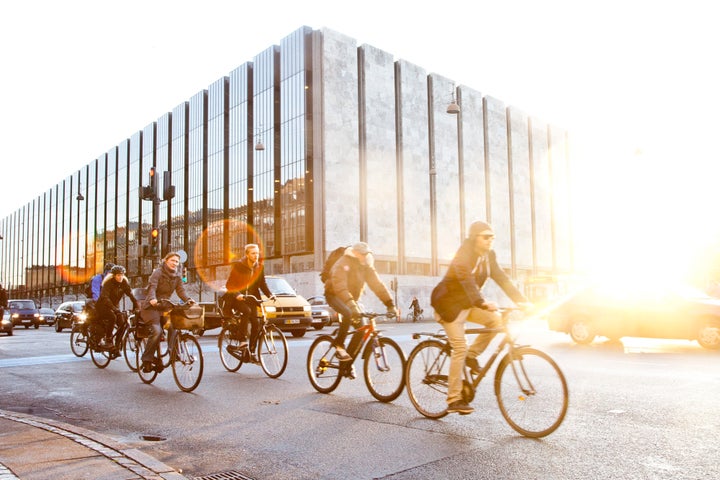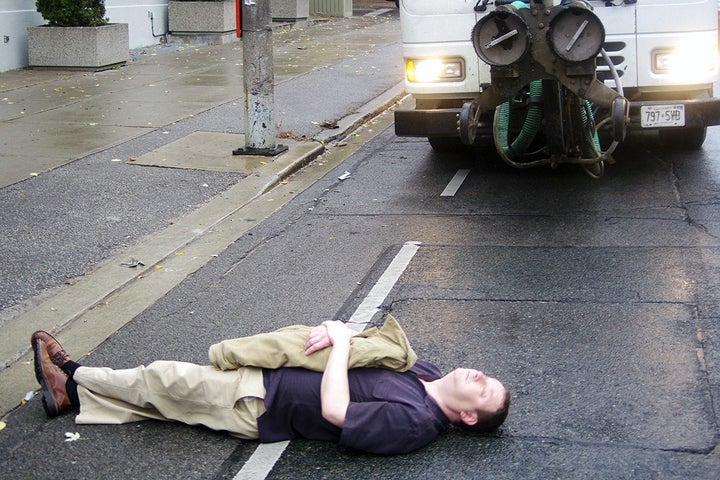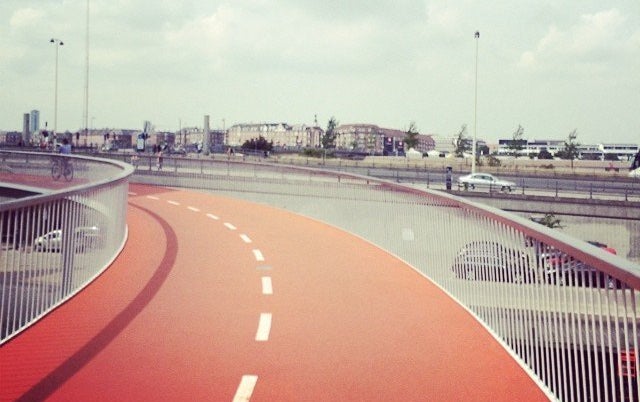
Calling from a hotel room in San Francisco last week, Swedish filmmaker Fredrik Gertten marveled at the swell of bikers he'd seen that morning while walking to a coffee shop.
“It’s kind of amazing," he said. "It almost looks like Copenhagen down at Market Street."
That counts as effusive praise from Gertten, the director of “Bikes vs Cars,” whose own favored mode of transit is quite clear. Gertten was in California for the U.S. theatrical release of his documentary, a look at the rise of the bicycle in cities around the world.
In the film, Gertten follows individuals in various cities at different points in their biking evolution. He focuses most on three places -- Los Angeles, where a comprehensive transit system gave way to massive sprawl but a bike culture is returning; São Paulo, where car use is skyrocketing but a biker’s death has rallied activists to push for safety measures; and Copenhagen, Denmark, where bike-friendly roads are shown as a taxi driver’s worst nightmare, but are also part of what makes the city heaven on earth for cyclists.
“About eight bikes equal a car in space,” Gertten told The Huffington Post. “It’s amazing to see here now in San Francisco, with a traffic light, with 10, 15 bikes waiting for a green light. If that had been 15 cars, that would be a very long line."
"If you can make that little equation in your brain, you will start to love bicycles, even if you will never go on a bike," he went on. "Even if you will be in a car for the rest of your life."
HuffPost talked to Gertten about what happens when millionaires ditch their cars, the latest innovations in biking infrastructure and how cyclists are pushing for big changes in cities.

One of the final scenes of “Bikes vs Cars” is of workers paving bike lanes in São Paulo in the middle of the night. What do you hope viewers leave the film with?
For me, the closing note is a note of coexistence, that bicyclists and motorists have to share the world. We can change our cities if we want.
People who are known to be quite conservative or right-wing have supported the film, and most of them have done so because they’re also bicyclists. So if you’re on a bike you get a different power perspective. On the street there is like a power hierarchy -- if you’re in a car, you’re on the top, and if you’re a pedestrian or a bicyclist, you’re on the bottom. So even if you make a million dollars a month, on a bike, when you’re out there in traffic, you’re a David.
So it’s not about left or right. It’s not even about having money or not having money. People make the choice: I don’t want to sit in the car. It’s boring, I lose my time, I get fat, I feel unhappy, I feel trapped. On a bike I feel free, I’m more flexible.
I don’t think all these people who are on bikes down here in San Francisco are conscious political people, you know, it’s not about that. It’s about how they want to live their lives. But what happens is, when people get harmed in traffic or even killed, if you are somebody who’s working at a law firm or if you work at a publicity company or wherever, and you ride a bike, you and your friends have [a] much better context to create a debate around bike safety. This is what’s happening now.
There’s a new class of people out there on bikes and they don’t take the shit, you know, and they are well-connected and they can make politics move, and this is happening now in a very speedy way. What I saw happening in São Paulo during the shoot of this film, nobody thought it could happen. I was back for the release of the film and there’s thousands of bikes out there. It’s now changing the face of the city, and this comes with safe bike infrastructure.

So São Paulo’s new bike lanes, that came as a surprise to you during filming?
It came as a total surprise, for me and for the bike activists. I was lucky to be in a place where change happened; I happened to catch one of the decisive moments. First was the death of this female bicyclist and then this guy who lost his arm. It became a very public story, and it became clear to so many that it was too much -- and that protest when people went to the mayor’s office, it was good timing, because that mayor had just come into power and he understood that this was something to go for. It’s not so hard for a politician to understand that bicycle infrastructure is a good thing for a city. Because if you go to Paris, if you go to London, if you go to New York -- it’s happening everywhere. So cities look at each other.
You talk about cars and bikes -- what about public transit?
I’m of course aware that public transit is essential, but my job as a filmmaker is sometimes also to highlight the conflict, and I thought the way of doing that is pitting bikes versus cars, because they are representing, let’s say, two extremes of city planning. The bike is kind of like a tool to make cities denser again...
[As] inner cities are getting really expensive... the people who are on bikes are the people who can afford to live in the cities. So that’s a new challenge, how to include people who have smaller resources. How can they be part of this society? How can they have a right to be on a bike? I think mobility overall is a human right.
A good society has good mobility for all, so if you have a society where the poorest part of the population has to spend two or three hours on transport every day, they are deprived a human right. But of course what happens in American cities is people with a lot of money are also deprived of their freedom of mobility because they’re spending so much time in traffic.
The idea of biking infrastructure and bike lanes is often seen as part of a wave of gentrification mostly happening in whiter and more affluent neighborhoods. Are there ways to make it more inclusive?
It’s the privileged upper-middle class who’s doing this bike revolution, and they are doing it because they have a different political power than the poor people in many countries. So if you are a part of that group, if you’re more privileged and you’re part of the bicycling movement, you should think about it -- I mean, not criticizing yourself, because what you do is right, but find a way to include people.
You can imagine if you’re a poor family living in the suburbs, people are spending 25 percent of their income on a car in the U.S. It’s a lot of money. So if you could cut the car spending away and put [it] into school for your kids or health care or food, it would make a hell of a difference.

What are the most innovative things going on in city planning for biking?
The potential for revolution is in the small details, and that’s the cool thing right now. Engaged people who love biking are talking to each other all over the world. Good ideas, good design travels in a totally new way. I think there’s also a lot of new knowledge pouring into the cities to see how they can solve things. The funny thing is that it happens in so many places at the same time, and it’s almost like a race between cities.
I think that the electric bike will be very important, because the electric bike means you can commute longer distances and is useful in places with sprawl and where winter is tougher.
In Copenhagen, they’re building more special bridges for bikes over the water. They’re working much more on more beautiful design for the bikes. It’s not only efficiency, it’s also beauty -- and I think there is a lot of symbolism in that. In my city, Malmö [Sweden], they have focused a lot on very cool bike parking at train stations, with protected parking, showers and toilets.
Overall, I think the revolution also lives in the attitude where a society that respects and loves their bicyclists is also a good society, and that’s kind of a mental shift. In the beginning it’s very complicated, but the more and more people who are out there on bikes, the better it is.
This interview has been edited and condensed for clarity. “Bikes vs Cars” opened in theaters around the U.S. last week. See the movie's website for more information.
Kate Abbey-Lambertz covers sustainable cities, housing and inequality. Tips? Feedback? Send an email or follow her on Twitter.
Also on HuffPost:

